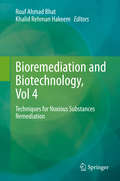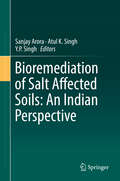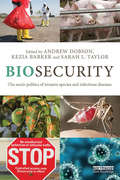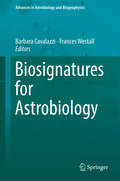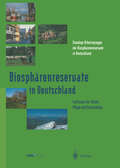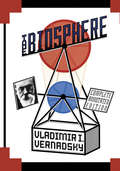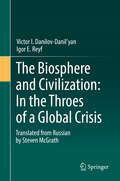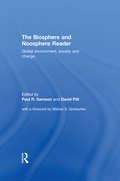- Table View
- List View
Bioremediation and Biotechnology, Vol 4: Techniques for Noxious Substances Remediation
by Rouf Ahmad Bhat Khalid Rehman HakeemThe rapid thriving of industries, conversion of agricultural land to residential areas, habitat destruction, deforestation and use of recalcitrant synthetic substances enhanced the rate of degradation of the environment. Although there are various conventional techniques for degradation and cleaning of noxious pollutants from disturbed environs, they are energy inefficient and costly to install. Bioremediation has emerged recently as an alternative and novel approach to manage and control environmental pollutants. This volume focuses explicitly on the remediation of noxious substances in stressed environs. It includes expert-contributed chapters on bio-monitoring by way of evaluating the relationship of biota with the polluted/stressed environs, sustainable plant-based degradation of noxious pollutants, and the application of biotechnologies to achieve tailored responses.Academicians, researchers, scientists and students will find this work essential for sustainable treatment of noxious pollutants. This book also serves as a core guide for training, teaching and research in conservation biology and environmental rehabilitation.
Bioremediation and Phytoremediation: Technologies for Toxic Pollution
by Ashwini A. WaooHuman health and wildlife are both affected by environmental contaminants. Plant-based bioremediation offers a cost-effective, non-intrusive, and natural alternative to chemical contamination by using plants and associated soil microbes to help reduce contaminants and their effects on the environment. This new volume provides an informative overview of the emerging issues related to bioremediation and phytoremediation. The author explains key concepts and aspects that underlie environmental awareness that have resulted in regulatory measures aimed at rectifying past mistakes and at protecting the environment from future contamination and exploitation. The book goes on to discuss alternative technologies for the removal of pollutants from the environment, restoring contaminated sites, and preventing further pollution using bioremediation. The multitude of bioremediation and phytoremediation technologies and methods covered include biochar for remediation, cyanobacteria, biosensors and bioindicators, rhizoremediation, and plant tissue culture studies.
Bioremediation and Phytoremediation: Technologies for Toxic Pollution
by Ashwini A. WaooHuman health and wildlife are both affected by environmental contaminants. Plant-based bioremediation offers a cost-effective, non-intrusive, and natural alternative to chemical contamination by using plants and associated soil microbes to help reduce contaminants and their effects on the environment. This new volume provides an informative overview of the emerging issues related to bioremediation and phytoremediation. The author explains key concepts and aspects that underlie environmental awareness that have resulted in regulatory measures aimed at rectifying past mistakes and at protecting the environment from future contamination and exploitation. The book goes on to discuss alternative technologies for the removal of pollutants from the environment, restoring contaminated sites, and preventing further pollution using bioremediation. The multitude of bioremediation and phytoremediation technologies and methods covered include biochar for remediation, cyanobacteria, biosensors and bioindicators, rhizoremediation, and plant tissue culture studies.
Bioremediation and Phytoremediation Technologies in Sustainable Soil Management: Volume 3: Inventive Techniques, Research Methods, and Case Studies (Innovations in Agricultural & Biological Engineering)
by Megh R. Goyal Junaid Ahmad MalikPhytoremediation has evolved into an important tool to improve the bioremediation process since it is an innovative green technology that uses a wide variety of plants to remediate radioactive metals and elements, organics, and chemicals from soil, sediment, surface water, and groundwater environmental pollutants. Together, bioremediation and phytoremediation technologies provide an effective approach to contaminant abatement. Volume 3 of the four-volume set identifies and draws a fresh image of existing developments in theoretical and functional implementation systems from recent scientific research studies that consider different facets of bioremediation. It also discusses the latest technology and prospects of new soil bioremediation technology and analyzes their domains, along with their associated challenges and consequences. Other volumes in the 4-volume set:• Volume 1: Fundamental Aspects and Contaminated Sites• Volume 2: Microbial Approaches and Recent Trends• Volume 4: Degradation of Pesticides and Polychlorinated Biphenyls Together, these four volumes provide in-depth coverage of the mechanisms, advantages, and disadvantages of the bioremediation and phytoremediation technologies for safe and sustainable soil management. The diverse topics help to arm biologists, agricultural engineers, environmental and soil scientists and chemists with the information and tools they need to address soil toxins that are a dangerous risk to plants, wildlife, humans and, of course, the soil itself.
Bioremediation and Phytoremediation Technologies in Sustainable Soil Management: Volume 4: Degradation of Pesticides and Polychlorinated Biphenyls (Innovations in Agricultural & Biological Engineering)
by Megh R. Goyal Junaid Ahmad Malik Khursheed Ahmad WaniThis 4-volume set focuses on the use of microbial bioremediation and phytoremediation to clean up pollutants in soil, such as pesticides, petroleum hydrocarbons, metals, and chlorinated solvents, which reduce the soil's fertility and renders it unfit for plant growth. The volumes cover the many diverse eco-friendly microbial bioremediation and phytoremediation techniques for sustainable soil management. Volume 4: Degradation of Pesticides and Polychlorinated Biphenyls addresses pesticide degradation, PCBs degradation, and genetic interventions. It begins by describing environmental pesticide degradation, mechanisms and sustainability, microbes and microbial enzymes, plant microbe interactions, organophosphorus degradations and endosulfan degradation. It then goes on to discuss PCBs and degradation, cypermethrin, degradation by Phanerochaete chrysosporium, and carvone and surfactants for degradation of PCBs. The book also advocates for genetic systems for degradation of PCBs and pesticides, with discussion of the different advantages and disadvantages for each strategy and the various techniques. Other volumes in the 4-volume set:• Volume 1: Fundamental Aspects and Contaminated Sites• Volume 2: Microbial Approaches and Recent Trends• Volume 3: Inventive Techniques, Research Methods, and Case Studies Together, these four volumes provide in-depth coverage of the mechanisms, advantages, and disadvantages of the bioremediation and phytoremediation technologies for safe and sustainable soil management.
Bioremediation and Phytoremediation Technologies in Sustainable Soil Management: Volume 4: Degradation of Pesticides and Polychlorinated Biphenyls (Innovations in Agricultural & Biological Engineering)
by Junaid Ahmad MalikThis 4-volume set focuses on the use of microbial bioremediation and phytoremediation to clean up pollutants in soil, such as pesticides, petroleum hydrocarbons, metals, and chlorinated solvents, which reduce the soil's fertility and renders it unfit for plant growth. The volumes cover the many diverse eco-friendly microbial bioremediation and phytoremediation techniques for sustainable soil management. Volume 4: Degradation of Pesticides and Polychlorinated Biphenyls addresses pesticide degradation, PCBs degradation, and genetic interventions. It begins by describing environmental pesticide degradation, mechanisms and sustainability, microbes and microbial enzymes, plant microbe interactions, organophosphorus degradations and endosulfan degradation. It then goes on to discuss PCBs and degradation, cypermethrin, degradation by Phanerochaete chrysosporium, and carvone and surfactants for degradation of PCBs. The book also advocates for genetic systems for degradation of PCBs and pesticides, with discussion of the different advantages and disadvantages for each strategy and the various techniques. Other volumes in the 4-volume set:• Volume 1: Fundamental Aspects and Contaminated Sites• Volume 2: Microbial Approaches and Recent Trends• Volume 3: Inventive Techniques, Research Methods, and Case Studies Together, these four volumes provide in-depth coverage of the mechanisms, advantages, and disadvantages of the bioremediation and phytoremediation technologies for safe and sustainable soil management.
Bioremediation and Phytoremediation Technologies in Sustainable Soil Management: Volume 3: Inventive Techniques, Research Methods, and Case Studies (Innovations in Agricultural & Biological Engineering)
by Junaid Ahmad MalikPhytoremediation has evolved into an important tool to improve the bioremediation process since it is an innovative green technology that uses a wide variety of plants to remediate radioactive metals and elements, organics, and chemicals from soil, sediment, surface water, and groundwater environmental pollutants. Together, bioremediation and phytoremediation technologies provide an effective approach to contaminant abatement. Volume 3 of the four-volume set identifies and draws a fresh image of existing developments in theoretical and functional implementation systems from recent scientific research studies that consider different facets of bioremediation. It also discusses the latest technology and prospects of new soil bioremediation technology and analyzes their domains, along with their associated challenges and consequences. Other volumes in the 4-volume set:• Volume 1: Fundamental Aspects and Contaminated Sites• Volume 2: Microbial Approaches and Recent Trends• Volume 4: Degradation of Pesticides and Polychlorinated Biphenyls Together, these four volumes provide in-depth coverage of the mechanisms, advantages, and disadvantages of the bioremediation and phytoremediation technologies for safe and sustainable soil management. The diverse topics help to arm biologists, agricultural engineers, environmental and soil scientists and chemists with the information and tools they need to address soil toxins that are a dangerous risk to plants, wildlife, humans and, of course, the soil itself.
Bioremediation and Phytoremediation Technologies in Sustainable Soil Management: Volume 2: Microbial Approaches and Recent Trends (Innovations in Agricultural & Biological Engineering)
by Junaid Ahmad MalikThis 4-volume set focuses on the use of microbial bioremediation and phytoremediation to clean up pollutants in soil, such as pesticides, petroleum hydrocarbons, metals, and chlorinated solvents, which reduce the soil's fertility and renders it unfit for plant growth. Volume 2: Microbial Approaches and Recent Trends focuses on new and emerging techniques and approaches to address soil pollution. These include the use of rhizobacteria, archaea, cyanobacteria, and microalgae as biofertilizers and for soil bioremediation efforts. New technologies for assessment of soil bioremediation are explored also. The chapters provide in-depth coverage of the mechanisms, advantages, and disadvantages of the technologies used and highlight the use of different microbial enzymes that are used in the process of bioremediation and phytoremediation to clean up different pollutants without causing damage to the natural environment. Other volumes in the 4-volume set:• Volume 1: Fundamental Aspects and Contaminated Sites• Volume 3: Inventive Techniques, Research Methods, and Case Studies• Volume 4: Degradation of Pesticides and Polychlorinated Biphenyls Together, these four volumes provide in-depth coverage of the mechanisms, advantages, and disadvantages of the bioremediation and phytoremediation technologies for safe and sustainable soil management. The diverse topics help to arm biologists, agricultural engineers, environmental and soil scientists and chemists with the information and tools they need to address soil toxins that are a dangerous risk to plants, wildlife, humans and, of course, the soil itself.
Bioremediation and Phytoremediation Technologies in Sustainable Soil Management: Volume 1: Fundamental Aspects and Contaminated Sites (Innovations in Agricultural & Biological Engineering)
by Junaid Ahmad MalikThis 4-volume set focuses on the use of microbial bioremediation and phytoremediation to clean up pollutants in soil, such as pesticides, petroleum hydrocarbons, metals, and chlorinated solvents, which reduce the soil's fertility and renders it unfit for plant growth. Volume 1: Fundamental Aspects and Contaminated Sites begins with an overview of phytoremediation and the role of environmental factors. It goes on to introduce soil assessment techniques and offers methods of remediation designed to combat soil and agricultural degradation. It discusses soils contaminated by heavy metals; microbial and phytoremediation-based removal of polycyclic aromatic hydrocarbons (PAHs) from coal, crude oil, and gasoline; microbial bioremediation and amelioration of pesticide-contaminated soils; phytoremediation techniques for biomedical waste contaminated sites; as well as biomediation processes for human waste sites. Biopesticides are also explained as an alternative to conventional pesticides. Other volumes in the 4-volume set:• Volume 2: Microbial Approaches and Recent Trends• Volume 3: Inventive Techniques, Research Methods, and Case Studies• Volume 4: Degradation of Pesticides and Polychlorinated Biphenyls Together, these four volumes provide in-depth coverage of the mechanisms, advantages, and disadvantages of the bioremediation and phytoremediation technologies for safe and sustainable soil management.
Bioremediation and Phytoremediation Technologies in Sustainable Soil Management: Volume 2: Microbial Approaches and Recent Trends (Innovations in Agricultural & Biological Engineering)
by Junaid Ahmad Malik Megh R. GoyalThis 4-volume set focuses on the use of microbial bioremediation and phytoremediation to clean up pollutants in soil, such as pesticides, petroleum hydrocarbons, metals, and chlorinated solvents, which reduce the soil's fertility and renders it unfit for plant growth. Volume 2: Microbial Approaches and Recent Trends focuses on new and emerging techniques and approaches to address soil pollution. These include the use of rhizobacteria, archaea, cyanobacteria, and microalgae as biofertilizers and for soil bioremediation efforts. New technologies for assessment of soil bioremediation are explored also. The chapters provide in-depth coverage of the mechanisms, advantages, and disadvantages of the technologies used and highlight the use of different microbial enzymes that are used in the process of bioremediation and phytoremediation to clean up different pollutants without causing damage to the natural environment. Other volumes in the 4-volume set:• Volume 1: Fundamental Aspects and Contaminated Sites• Volume 3: Inventive Techniques, Research Methods, and Case Studies• Volume 4: Degradation of Pesticides and Polychlorinated Biphenyls Together, these four volumes provide in-depth coverage of the mechanisms, advantages, and disadvantages of the bioremediation and phytoremediation technologies for safe and sustainable soil management. The diverse topics help to arm biologists, agricultural engineers, environmental and soil scientists and chemists with the information and tools they need to address soil toxins that are a dangerous risk to plants, wildlife, humans and, of course, the soil itself.
Bioremediation and Phytoremediation Technologies in Sustainable Soil Management: Volume 1: Fundamental Aspects and Contaminated Sites (Innovations in Agricultural & Biological Engineering)
by Junaid Ahmad Malik Megh R. Goyal Khursheed Ahmad WaniThis 4-volume set focuses on the use of microbial bioremediation and phytoremediation to clean up pollutants in soil, such as pesticides, petroleum hydrocarbons, metals, and chlorinated solvents, which reduce the soil's fertility and renders it unfit for plant growth. Volume 1: Fundamental Aspects and Contaminated Sites begins with an overview of phytoremediation and the role of environmental factors. It goes on to introduce soil assessment techniques and offers methods of remediation designed to combat soil and agricultural degradation. It discusses soils contaminated by heavy metals; microbial and phytoremediation-based removal of polycyclic aromatic hydrocarbons (PAHs) from coal, crude oil, and gasoline; microbial bioremediation and amelioration of pesticide-contaminated soils; phytoremediation techniques for biomedical waste contaminated sites; as well as biomediation processes for human waste sites. Biopesticides are also explained as an alternative to conventional pesticides. Other volumes in the 4-volume set:• Volume 2: Microbial Approaches and Recent Trends• Volume 3: Inventive Techniques, Research Methods, and Case Studies• Volume 4: Degradation of Pesticides and Polychlorinated Biphenyls Together, these four volumes provide in-depth coverage of the mechanisms, advantages, and disadvantages of the bioremediation and phytoremediation technologies for safe and sustainable soil management.
Bioremediation of Salt Affected Soils: An Indian Perspective
by Sanjay Arora Atul K. Singh Y. P. SinghThis edited volume focuses on the characterization, reclamation, bioremediation, and phytoremediation of salt affected soils and waterlogged sodic soils. Innovative technologies in managing marginal salt affected lands merit immediate attention in the light of climate change and its impact on crop productivity and environment. The decision-making process related to reclamation and management of vast areas of salt affected soils encompasses consideration of economic viability, environmental sustainability, and social acceptability of different approaches. The chapters in this book highlight the significant environmental and social impacts of different ameliorative techniques used to manage salt affected soils. Readers will discover new knowledge on the distribution, reactions, changes in bio-chemical properties and microbial ecology of salt affected soils through case studies exploring Indian soils. The contributions presented by experts shed new light on techniques such as the restoration of degraded lands by growing halophyte plant species, diversification of crops and introduction of microbes for remediation of salt infested soils, and the use of fluorescent pseudomonads for enhancing crop yields.
Bioremediation of Soils Contaminated with Aromatic Compounds (Nato Science Series: IV: #76)
by Hermann J. HeipieperThis book represents a compilation of the major contributions of a NATO workshop on bioremediation of soils contaminated with aromatic compounds, which took place in Tartu, Estonia. It demonstrates the importance and necessity of interdisciplinary research in modern environmental biotechnology.
Biorights: The Neo-economic Conservation Paradigm for Global South (Studies in Ecological Economics #7)
by Dipayan Dey Joyashree RoyThis book evaluates local conservation successes of global south in the climate milieu, as an empirical evidence of ‘Bio-rights’ of commons at community-ecosystem interface for sustainable intensification of nature’s goods and services. Bio-rights is a right-based neo-economic conservation paradigm that compensates the opportunity costs incurred in conservation efforts by the marginal communities, living near globally important ecosystems and dependent on it for their livelihood, through payments from environment services. The book would bring forth the true value of circular economic interventions in socio-ecological conservation, shaped through sustainable human interactions with nature. This multilevel study of conservation science serves an interdisciplinary academia, consistent with conventions on climate change, bio-diversity and sustainable development, to establish links between conservation priorities and development objectives. Herein, Bio-rights is introduced as a ‘design approach’ for production linked sustainable development, supplemented with case studies from the east.
Biosaline Agriculture as a Climate Change Adaptation for Food Security
by Redouane Choukr-Allah Ragab RagabThis book presents recent research work on Biosaline Agriculture presented during First International Forum on Biosaline Agriculture in Laayoune, Morocco from May 3rd to May 4th 2019. The aim of this book is to showcase the global potential of Biosaline agriculture, provide an update on the development of recent innovations in the field of Biosaline agriculture, the best management practices to safely use brackish and saline water, highlight the use of non-conventional water in marginal environment production and the current advanced technologies of desalination of brackish and seawater. The different chapters will also discuss solutions that are adapted to local conditions as part of a sustainable development perspective. The book provides up-to-date technical and scientific data on growing crops under marginal environment so as to encourage the dissemination of this knowledge in the best practices to increase the productivity in Biosaline agriculture, in view of the potential to contribute to food security. The book is expected to stimulate interest in the non-conventional water resources and crops among junior and senior researchers and among those who are increasingly focused on exploiting marginal environments. It will also be of interest to decision-makers and the public and private sectors to jointly address the issues of food security especially of the poor and vulnerable people living in marginal environments worldwide by providing innovative technology transfer.
Biosecurity: The Socio-Politics of Invasive Species and Infectious Diseases
by Andrew Dobson Kezia Barker Sarah L. TaylorBiosecurity is the assessment and management of potentially dangerous infectious diseases, quarantined pests, invasive (alien) species, living modified organisms, and biological weapons. It is a holistic concept of direct relevance to the sustainability of agriculture, food safety, and the protection of human populations (including bio-terrorism), the environment, and biodiversity. Biosecurity is a relatively new concept that has become increasingly prevalent in academic, policy and media circles, and needs a more comprehensive and inter-disciplinary approach to take into account mobility, globalisation and climate change. In this introductory volume, biosecurity is presented as a governance approach to a set of concerns that span the protection of indigenous biological organisms, agricultural systems and human health, from invasive pests and diseases. It describes the ways in which biosecurity is understood and theorized in different subject disciplines, including anthropology, political theory, ecology, geography and environmental management. It examines the different scientific and knowledge practices connected to biosecurity governance, including legal regimes, ecology, risk management and alternative knowledges. The geopolitics of biosecurity is considered in terms of health, biopolitics and trade governance at the global scale. Finally, biosecurity as an approach to actively secure the future is assessed in the context of future risk and uncertainties, such as globalization and climate change.
Biosecurity: The Socio-Politics of Invasive Species and Infectious Diseases
by Andrew Dobson Kezia Barker Sarah L. TaylorBiosecurity is the assessment and management of potentially dangerous infectious diseases, quarantined pests, invasive (alien) species, living modified organisms, and biological weapons. It is a holistic concept of direct relevance to the sustainability of agriculture, food safety, and the protection of human populations (including bio-terrorism), the environment, and biodiversity. Biosecurity is a relatively new concept that has become increasingly prevalent in academic, policy and media circles, and needs a more comprehensive and inter-disciplinary approach to take into account mobility, globalisation and climate change. In this introductory volume, biosecurity is presented as a governance approach to a set of concerns that span the protection of indigenous biological organisms, agricultural systems and human health, from invasive pests and diseases. It describes the ways in which biosecurity is understood and theorized in different subject disciplines, including anthropology, political theory, ecology, geography and environmental management. It examines the different scientific and knowledge practices connected to biosecurity governance, including legal regimes, ecology, risk management and alternative knowledges. The geopolitics of biosecurity is considered in terms of health, biopolitics and trade governance at the global scale. Finally, biosecurity as an approach to actively secure the future is assessed in the context of future risk and uncertainties, such as globalization and climate change.
Biosignatures for Astrobiology (Advances in Astrobiology and Biogeophysics)
by Barbara Cavalazzi Frances WestallThis book aims at providing a brief but broad overview of biosignatures. The topics addressed range from prebiotic signatures in extraterrestrial materials to the signatures characterising extant life as well as fossilised life, biosignatures related to space, and space flight instrumentation to detect biosignatures either in situ or from orbit. The book ends with philosophical reflections on the implications of life elsewhere. In the 15 chapters written by an interdisciplinary team of experts, it provides both detailed explanations on the nature of biosignatures as well as useful case studies showing how they are used and identified in ancient rocks, for example. One case study addresses the controversial finding of traces of fossil life in a meteorite from Mars. The book will be of interest not only to astrobiologists but also to terrestrial paleontologists as well as any reader interested in the prospects of finding a second example of life on another planet.
Biosphäre 4.0: UNESCO Biosphere Reserves als Modellregionen einer nachhaltigen Entwicklung
In diesem Buch erfahren Sie, was Biosphere Reserves eigentlich sind?! Warum wurden sie gegründet? Wie werden sie verwaltet? Und was haben sie mit Nachhaltigkeit zu tun? Angesprochen sind alle, die in diesem Bereich arbeiten oder forschen, diese führen und verwalten, sowie Politikerinnen, Politiker oder Wirtschaftstreibende die sich mit Wegen zur Nachhaltigkeit beschäftigen. Sie werden überrascht sein über die Vielfalt der Fragestellungen und Probleme, vor allem aber über die Strategien und Lösungen, die in Deutschland, Österreich und der Schweiz erarbeitet wurden.
Biosphärenreservate in Deutschland: Leitlinien für Schutz, Pflege und Entwicklung
by K. H. ErdmannIn den Biosphärenreservaten steht nicht der konservierende Naturschutz im Vordergrund, sondern das Bemühen um ein harmonisches Miteinander von Natur und wirtschaftenden Menschen. Die allgemein gültigen Leitlinien für Schutz, Pflege und Entwicklung der Reservate werden ergänzt durch die Berücksichtigung ökonomischer, sozialer, kultureller und ethischer Aspekte.Die Arbeitsgruppe der Biosphärenreservate in Deutschland berichtet detailliert über die beispielhafte Erarbeitung und Umsetzung der Konzepte für Schutz, Pflege und Entwicklung der 12 deutschen, von der UNESCO anerkannten Kulturlandschaften.Ihre Publikation bietet zahlreiche Anregungen und kompetente Anleitung auch für die Planung und Durchführung allgemein gültiger Naturschutzkonzepte.
The Biosphere
by Vladimir I. Vernadsky"Vladimir Vernadsky was a brilliant and prescient scholar-a true scientific visionary who saw the deep connections between life on Earth and the rest of the planet and understood the profound implications for life as a cosmic phenomenon." -DAVID H. GRINSPOON, AUTHOR OF VENUS REVEALED"The Biosphere should be required reading for all entry level students in earth and planetary sciences." -ERIC D. SCHNEIDER, AUTHOR OF INTO THE COOL: THE NEW THERMODYNAMICS OF CREATIVE DESTRUCTION
The Biosphere and Civilization: In the Throes of a Global Crisis
by Victor I. Danilov-Danil'yan Igor E. ReyfThis monograph explores the dire ecological, social, and economic situations facing mankind through comprehensive analyses of global ecological issues, poverty, environmental stability and regulation, and sustainable development. Drs. Victor Danilov-Danil’yan and Igor Reyf discuss the development of ecology as a science, the increasing concern among scientists and public servants for the unsustainability of current economic and demographic trends, and the dire consequences our planet and civilization are already suffering as a result of the ongoing environmental and social crisis. They also address the philosophical implications of the crisis, and suggest possible solutions. The book conveys complex objects of study, namely the biosphere and the harmful anthropogenic processes it has been experiencing for decades, so that the work is accessible without omitting key components of the subject matter. Readers will learn about the social and economic contributors to a threatened biosphere, the mechanisms that maintain the stability of the global environment, and the scales at which sustainable development and preservation can be applied to initiate environmental regulation. Though intended to appeal to the general public and non-specialists, environmental researchers, organizations involved in sustainable development and conservation, and students engaged in ecology, environment, and sustainability studies will also find this book of interest.
Biosphere and Environmental Safety
by V. I. OsipovThis book analyses the state of the natural environment and the causes of its degradation using the biosphere approach. Further, those issues that must be resolved immediately on the global level are identified following the ideas defined by V.I. Vernadsky, and new principles of Man-Nature interaction are pursued. The modern world currently faces three global trends inducing biosphere degradation and the aggravation of ecological hazards, namely: a) rapid and uncontrolled growth of human population on the Earth and insufficient natural resources to sustain it; (b) technogenesis development; and (c) global climate change and the aggravation of natural disasters. Ecological safety and military security are becoming the crucial conditions for the survival of modern civilization. To mitigate the ecological strain on the Earth, the technogenesis strategy should be changed and many other pressing issues must be resolved. These problems should be addressed using the biosphere approach, because the individual human being is the biosphere constituent, and his or her safety cannot be provided without maintaining the entire natural system on our planet.
The Biosphere and Noosphere Reader: Global Environment, Society and Change
by David Pitt Paul R. SamsonThe Reader is the first comprehensive history of the noosphere and biosphere. Drawing on classical influences, modern parallels, and insights into the future, the Reader traces the emergence of noosphere and biosphere concepts within the concept of environmental change. Reproducing material from seminla works, both past and present, key ideas and writings of prominent thinkers are presented, including Bergson, Vernadsky, Lovelock, Russell, Needham, Huxley, Medawar, Toynbee and Boulding, and extensive introductory pieces bu the editors drawattention to common themes and competing ideas. Focussing on issues of origins, theories, parallels and potential, the discussions place issues in a broad context, compare and contrast central concepts with those of the Gaia hypothesis, sustainability and global change, and examine the potential application of noospheric ideas to current debates about culture, education and technology in such realms as the Internet, space exploration, and the emergence of super-consciousness. Literally the `sphere of mind or intellect', the noosphere is aprt of the `realm of the possible' in human affairs, where there is a conscious effort to tackle global issues The noosphere concept captures a number of key contemporary issues - social evolution, global ecology, Gaia, deep ecology and global environmental change - contributing to ongoing debates concerning the implications of emerging technologies.
The Biosphere and Noosphere Reader: Global Environment, Society and Change
by Paul R. Samson David PittThe Reader is the first comprehensive history of the noosphere and biosphere. Drawing on classical influences, modern parallels, and insights into the future, the Reader traces the emergence of noosphere and biosphere concepts within the concept of environmental change. Reproducing material from seminla works, both past and present, key ideas and writings of prominent thinkers are presented, including Bergson, Vernadsky, Lovelock, Russell, Needham, Huxley, Medawar, Toynbee and Boulding, and extensive introductory pieces bu the editors drawattention to common themes and competing ideas. Focussing on issues of origins, theories, parallels and potential, the discussions place issues in a broad context, compare and contrast central concepts with those of the Gaia hypothesis, sustainability and global change, and examine the potential application of noospheric ideas to current debates about culture, education and technology in such realms as the Internet, space exploration, and the emergence of super-consciousness. Literally the `sphere of mind or intellect', the noosphere is aprt of the `realm of the possible' in human affairs, where there is a conscious effort to tackle global issues The noosphere concept captures a number of key contemporary issues - social evolution, global ecology, Gaia, deep ecology and global environmental change - contributing to ongoing debates concerning the implications of emerging technologies.
